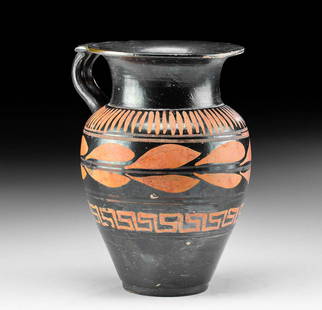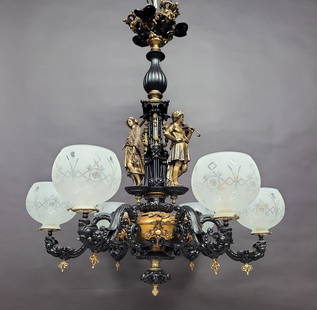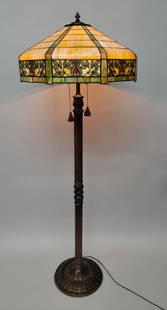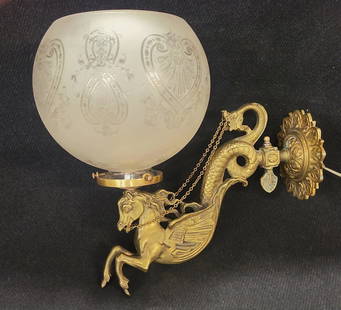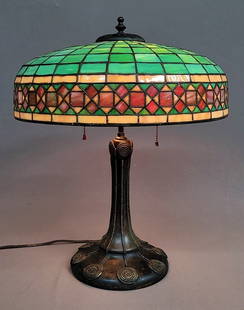
Greek Apulian Polychrome Olpe w/ Lady of Fashion
Similar Sale History
View More Items in Tableware & BarwareRelated Tableware & Barware
More Items in Tableware & Barware
View MoreRecommended Home & Décor
View More






Item Details
Description
Magna Graecia, South Italy, Apulian, ca. 4th century BCE. A gorgeous Apulian olpe of an attractive form comprised of an ample body, a cylindrical neck that flares at the rim, and a Herakles knot handle joining rim to shoulder. The body is finely painted via the red-figure technique with the head of a Lady of Fashion in profile bedecked with jewelry and a saccos with radiate stephane, all delineated via the red figure technique with white fugitive pigment details. Adding to the decorative program is a composite palmette beneath the handle, a register of laurel leaves along the neck framed by two narrow bands. A fabulous example, replete with impressive artistry and especially lovely given the Herakles knot handle. Size: 5.25" in diameter x 6.375" H (13.3 cm x 16.2 cm)
According to the British Museum, "The marriage-knot or knot of Hercules, a strong knot created by two intertwined ropes, originated as a healing charm in ancient Egypt, but is best known for its use in ancient Greece and Rome as a protective amulet, most notably as a wedding symbol. The symbolism of the knot survived well beyond its religious use and was a common symbol in medieval and Renaissance love tokens." In addition, according to Roman historian Pliny, the Herakles knot had the ability to cure wounds.
Perhaps the most exciting innovation in Greek vase painting was the red-figure technique, invented in Athens around 525 BCE and beloved by other artists of Magna Graecia. The red-figure technique allowed for much greater flexibility as opposed to the black-figure technique, for now the artist could use a soft, pliable brush rather than a rigid metal graver to delineate interior details, play with the thickness of the lines, as well as build up or dilute glazes to create chromatic effects. The painter would create figures by outlining them in the natural red of the vase, and then enrich these figural forms with black lines to suggest volume, at times perspectival depth, and movement, bringing those silhouettes and their environs to life. Beyond this, fugitive pigments made it possible for the artist to create additional layers of interest and detail as we see in this example.
Provenance: private Corpus Christi, Texas, USA estate collection, acquired 1960s to 1970s
All items legal to buy/sell under U.S. Statute covering cultural patrimony Code 2600, CHAPTER 14, and are guaranteed to be as described or your money back.
A Certificate of Authenticity will accompany all winning bids.
We ship worldwide to most countries and handle all shipping in-house for your convenience.
#165468
According to the British Museum, "The marriage-knot or knot of Hercules, a strong knot created by two intertwined ropes, originated as a healing charm in ancient Egypt, but is best known for its use in ancient Greece and Rome as a protective amulet, most notably as a wedding symbol. The symbolism of the knot survived well beyond its religious use and was a common symbol in medieval and Renaissance love tokens." In addition, according to Roman historian Pliny, the Herakles knot had the ability to cure wounds.
Perhaps the most exciting innovation in Greek vase painting was the red-figure technique, invented in Athens around 525 BCE and beloved by other artists of Magna Graecia. The red-figure technique allowed for much greater flexibility as opposed to the black-figure technique, for now the artist could use a soft, pliable brush rather than a rigid metal graver to delineate interior details, play with the thickness of the lines, as well as build up or dilute glazes to create chromatic effects. The painter would create figures by outlining them in the natural red of the vase, and then enrich these figural forms with black lines to suggest volume, at times perspectival depth, and movement, bringing those silhouettes and their environs to life. Beyond this, fugitive pigments made it possible for the artist to create additional layers of interest and detail as we see in this example.
Provenance: private Corpus Christi, Texas, USA estate collection, acquired 1960s to 1970s
All items legal to buy/sell under U.S. Statute covering cultural patrimony Code 2600, CHAPTER 14, and are guaranteed to be as described or your money back.
A Certificate of Authenticity will accompany all winning bids.
We ship worldwide to most countries and handle all shipping in-house for your convenience.
#165468
Condition
Collection label on base. Repaired from several large piece with restoration. Expected nicks and abrasions as shown. Otherwise, very nice with lovely pigments.
Buyer's Premium
- 24.5%
Greek Apulian Polychrome Olpe w/ Lady of Fashion
Estimate $1,000 - $1,500
14 bidders are watching this item.
Shipping & Pickup Options
Item located in Louisville, CO, usOffers In-House Shipping
Local Pickup Available
Payment

Related Searches
TOP






















